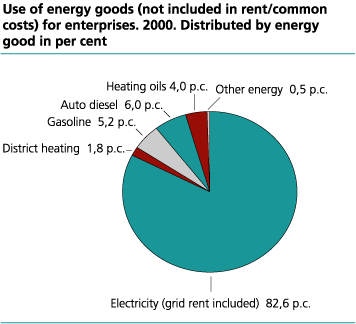Consumption of energy in commerce, hotels and restaurants
83 per cent of the energy was electricity
Published:
Electricity is by far the largest energy commodity in commerce, hotels and restaurants. The consumption of electric energy in these industries was 7.5 TWh in 2000. This amounts to 83 percent of the consumption of energy.
These are some results from Statistics Norway's new survey of energy use in commerce, hotels and restaurants. The figures do not include use of energy included in rent or common costs.
Heating oils was the second largest energy commodity used for stationary purposes. In 2000 the fraction of the total energy consumption was 4 per cent, or 0,4 TWh. The consumption of district heating only amounted to 1.8 per cent in 2000 for these industries.
The energy commodities gasoline and auto diesel amounted to 11.2 per cent of the energy use. But the fraction is considerably larger as regards to the costs. The gasoline and auto diesel costs in 2000 was NOK 882 million and this amounted to 22.3 per cent of the total energy costs. The other energy commodities like kerosene, fluid propane and butane amounted to less than 1 per cent of the total consumption of energy.
Consumption of energy included in the rent/common costs is not included in the figures above. Including the estimated energy consumption paid in this way, the consumption of energy in 2000 was about 9.5 TWh within commerce, hotels and restaurants. This amounts to NOK 4.1 billion, exclusive of value added tax. NOK 158 million of this was paid through rent/common costs.
Small differences in the prices of energy
The differences in the prices of energy commodities used for stationary purposes were relatively small within commerce, hotels and restaurants in 2000. Average price of electric energy, district heating and heating oils were 37.8 øre/kWh, 38.7 øre/kWh and 35 øre/kWh respectively, inclusive of all taxes but except for value added tax. In the price of electric energy grid rent is included. Average price for all the energy commodities except gasoline and auto diesel was 38 øre/kWh.
Electricity most common in retail trade
The largest energy consumption in this survey took place in retail trade. It constituted 3.6 TWh in 2000. As much as 93 per cent of this was electric energy, corresponding to 3.4 TWh. Electricity amounts to 82.6 per cent of the total consumption of energy in all the industries in this survey.
Little energy from district heating
The consumption of district heating in commerce, hotels and restaurants was only 162 GWh in 2000, and amounted to only 2 per cent of the energy used for stationary purposes. Consumption of energy paid through rent/common costs is excluded. But this only amounts to about 4 per cent of the total energy costs. District heating was least widespread in retail trade, where it amounted to 0.5 per cent.
Wholesale trade and commission trade was the industry in this survey using most district heating. 4.4 per cent of the total energy consumption except for gasoline and auto diesel was district heating in this industry. That is almost half of the total consumption of district heating within commerce, hotels and restaurants in 2000.
Fluid propane and butane in restaurants
The consumption of fluid propane and butane was 5 476 million litre, corresponding about 37 GWh. This was mostly used in hotels and restaurants. 25 GWh was used in this industry, where 20.6 GWh was in restaurants. With that, the consumption of fluid propane and butane within restaurants amounted to 55.4 per cent of the total consumption of propane and butane.
In this survey the classification Hotels and restaurants includes hotels, restaurants and canteens and catering. Other accommodation and bars are not included.
See also: NOS Energy Statistics 2000
Tables
- Table 1 Use of energy goods (not included in rent/common costs) for enterprises in commerce, hotels and restaurants. 2000. An overview
- Table 2 Use of energy goods (not included in rent/common costs) for enterprises, by industry. 2000
- Table 3 Use of energy goods (not included in rent/common costs) for enterprises, by industry. 2000. 1 000 kWh
- Table 4 Price of energy goods (not included in rent/common costs) for enterprises, by industry. 2000. Øre/kWh
- Table 5 Energy costs and use of energy goods for enterprices, by industry. 2000
- Table 6 Use of energy goods (not included in rent/common costs) for enterprises. Distributed in per cent, by industry. 2000
- Table 7 Use of energy goods (not included in rent/common costs) for enterprises. Distributed in per cent, by energy good. 2000
Contact
-
Statistics Norway's Information Centre

